Book your 360Learning demo now
A 30-minute overview of the platform
100% tailored to your needs - with ❤️
No commitment. Free as can be.
In this environment, training and onboarding your new hires is key to maintaining productivity and performance. This is especially true if you are bringing on new staff to plug gaps related to the current crisis.
But onboarding employees has suddenly become trickier than ever. Some companies went into lockdown in the middle of hiring. Others have fresh staff in the heart of training and trial periods.
Your employee onboarding processes must be flexible and nimble, and should adjust to interruptions and changes in the way you work.
To help, we hosted a webinar with our friends over at Spendesk to share a few tips and tricks from our onboarding playbook.
Our Head of Learning, Jonah Goldstein, got together with Raphaël Moutard, Senior Engineer at Spendesk, to discuss how to meet the challenge of onboarding new employees from afar, and some specific techniques you can use.
In this recap, we’ll run you through six key steps to great remote onboarding - and a few things you should avoid, or you can download our comprehensive ebook, below, for the full picture.

By providing your contact info, you agree to receive communications from 360Learning. You can opt-out at any time. For details, refer to our Privacy Policy.
Whether you’re onboarding staff in person or remotely, the fundamentals remain the same: you need to start strong with great pre-boarding.
Pre-boarding is everything that happens from contract signing to arriving at the office - or signing in for Day One from home.
Your new hires need access to your systems, including email or chat, project management, time tracking instructions, learning modules, and anything else they’ll be using from day-to-day. This might sound like a no-brainer, but access issues are one of the most common first-day problems.
With remote onboarding, this communication is even more important - you want your new hire to feel plugged-in to the workplace, even if they can’t be physically present.
Pre-boarding might seem like a basic admin task, but overlooking this important step jeopardizes a smooth first day for your new hire. Any first day is stressful and starting a new job remotely in the middle of a pandemic even more so. You don’t want them to have to worry about getting their computers or Gmail access, too.
“The anxiety someone can feel when starting a new job is always exacerbated by not knowing the key details,” says Jonah.
“We want the logistics to run really smoothly, and to communicate clearly to new hires about what to expect when they start.”
A shared learning platform lets your new hires build their capabilities and get to know the business in detail - even from afar.
Here’s a sense of what our pre-boarding logistics look like in practice at 360Learning, including the key tasks to be completed:
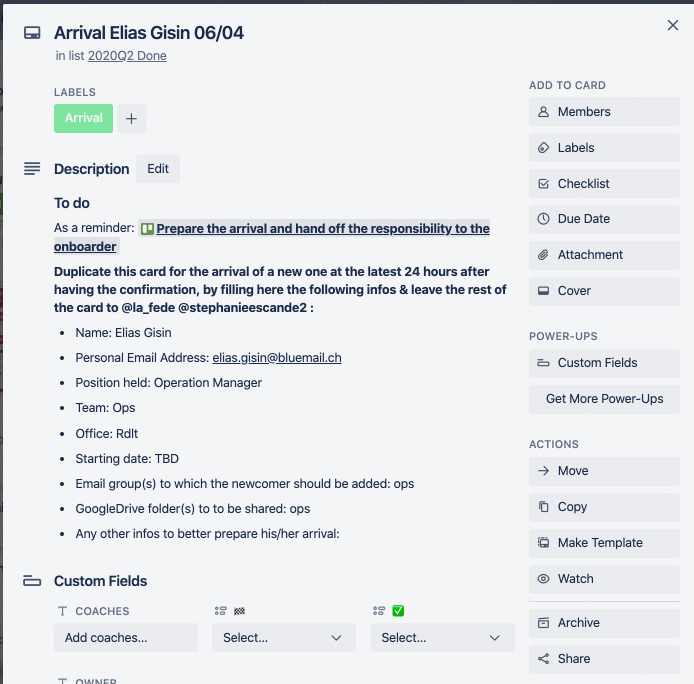
Our pre-boarding modules also include detailed guidance and information on key aspects of company culture, like our communication preferences.
We have a deliberate way of communicating which helps to set the tone for the entire company. For example, we’re huge believers in asynchronous work and aren’t big on emails or any other 1:1 form of communication.
This communication culture can seem strange for new arrivals, so it’s important to explain this nice and early in pre-boarding, and in clear and simple terms:
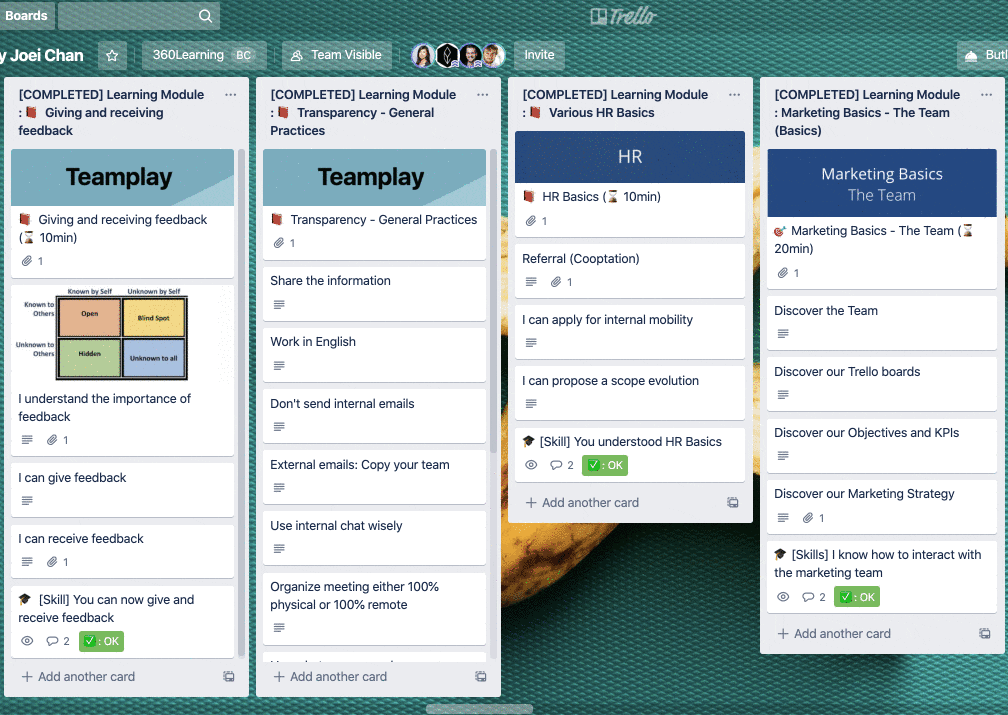
Related: Why Top-Down Management Doesn't Work
After great pre-boarding, the second most important step in remote onboarding is collaboration.
As Jonah explains, we think of collaboration as a two-part process at 360Learning. “First, there’s collaboration in creating onboarding content, then there’s collaboration during the onboarding process. These are both equally important.”
Onboarding is the process of introducing your new hires to everything they need to know to do their jobs.
And everything they need to know can be a lot. And here I’m speaking for the HR or L&D teams. It’s impossible for them to know everything every new hire needs to know.
And this brings us to the first part of onboarding collaboration: empowering your subject matter experts to share their knowledge, no matter which team they’re from.
With a learning platform, anyone in your business can design and author learning modules. Even better, they can seek input and feedback from others as they go.
Decentralizing onboarding content creation makes everybody’s lives easier. Less pressure for the HR or L&D teams, more invested interest from the rest of the company in the onboarding process, more interactions for the new hire with all departments - everybody wins.
Related: Centralized vs. Decentralized - Which is the Right L&D Approach for Your Business?
On top of content creation, collaborative learning should also happen during the onboarding process.
At 360Learning, we make use of the collaborative features on our learning platform to encourage interactions and collaboration.
This includes our discussion forum, where new hires can ask questions anytime, and offer instant reactions to each module, as they are taking each course. Most of the time, questions asked in forums are answered immediately by the course author or fellow colleagues.
With these interactions and responses, every one of your courses and modules becomes a living document and is a collection of all the expertise, questions, and learning experiences of your previous learners.
This helps new hires understand the courses better, and create a sense of community. This is especially valuable in a remote onboarding or learning process, which could feel lonely.
This also helps the course author improve and iterate on the courses, continuously improving the quality of the course content. Another great way to encourage collaboration is to host virtual team building activities.
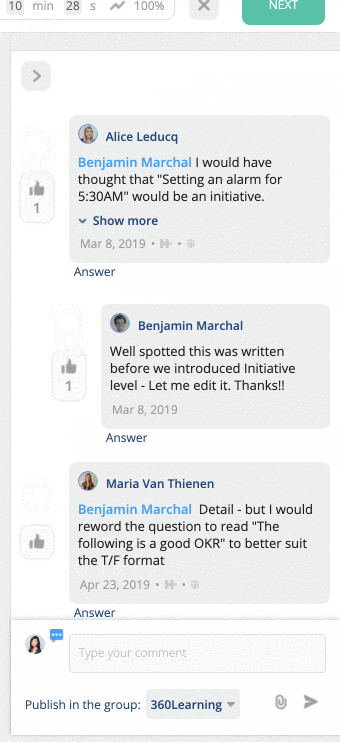
Related: How We Use Peer Learning to Keep Our Company’s Competitive Edge
Every great onboarding process is collaborative, engaging, and tailored to the needs and expectations of each hire that were made clear in their application, cover letter and interview process. This goes for remote onboarding, too.
While there are common elements in the onboarding experience for every new hire, to really prepare them for their new job, you need to offer customized learning paths that provide information and support for each role and their learning needs and speed.
“The best thing to show a new learner you care, especially when working remotely, is to give them time to absorb information, and to stay flexible,” says Raphaël. “Not everyone’s situation is the same, and your onboarding process needs to reflect that.”
“Not everyone’s situation is the same, and your onboarding process needs to reflect that.”
In practice, this means tailoring learning content to each new hire and giving them enough freedom and flexibility to progress at their own pace.
At 360Learning, we use a mix of standardized and customized training content for each learner and give our new hires a degree of flexibility in their learning process. An example of what that looks like:
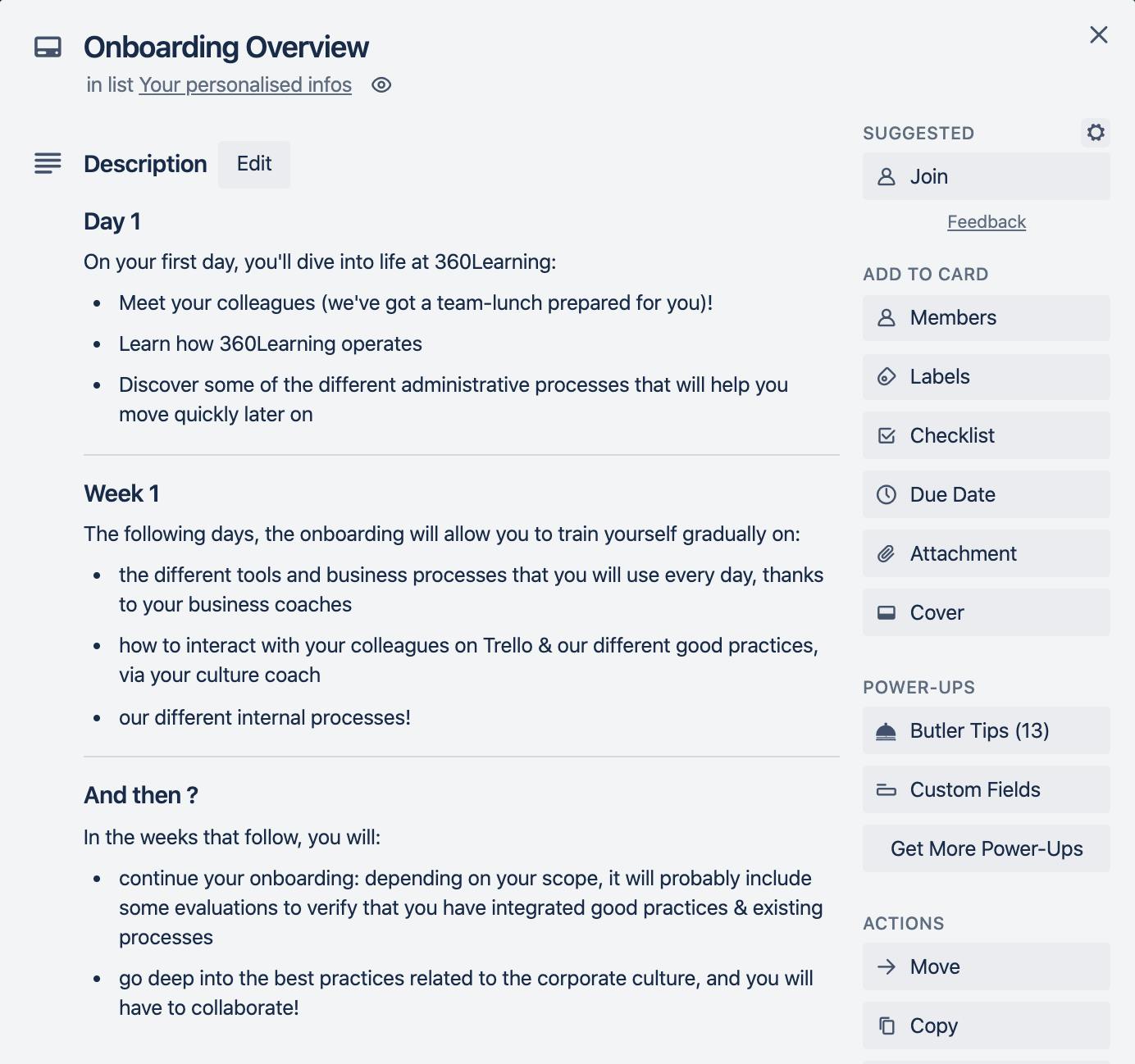
It can be easy for new hires to get distracted from their onboarding and training - especially when people are learning remotely.
To help keep people focused and engaged, use checklists of onboarding activities, and don’t be afraid to give people the occasional nudge.
This can be as simple as setting up onboarding reminders or using your project management tool of choice. In any case, checklists and nudges offer visible progress indicators for learners and create positive reinforcement for learners.
“At Spendesk, we use checklists as a way for new hires to stay engaged,” says Raphaël. “Otherwise, they can get lost in the immensity of everything they have to learn.”
Here’s what these onboarding checklists and nudges look like at 360Learning:
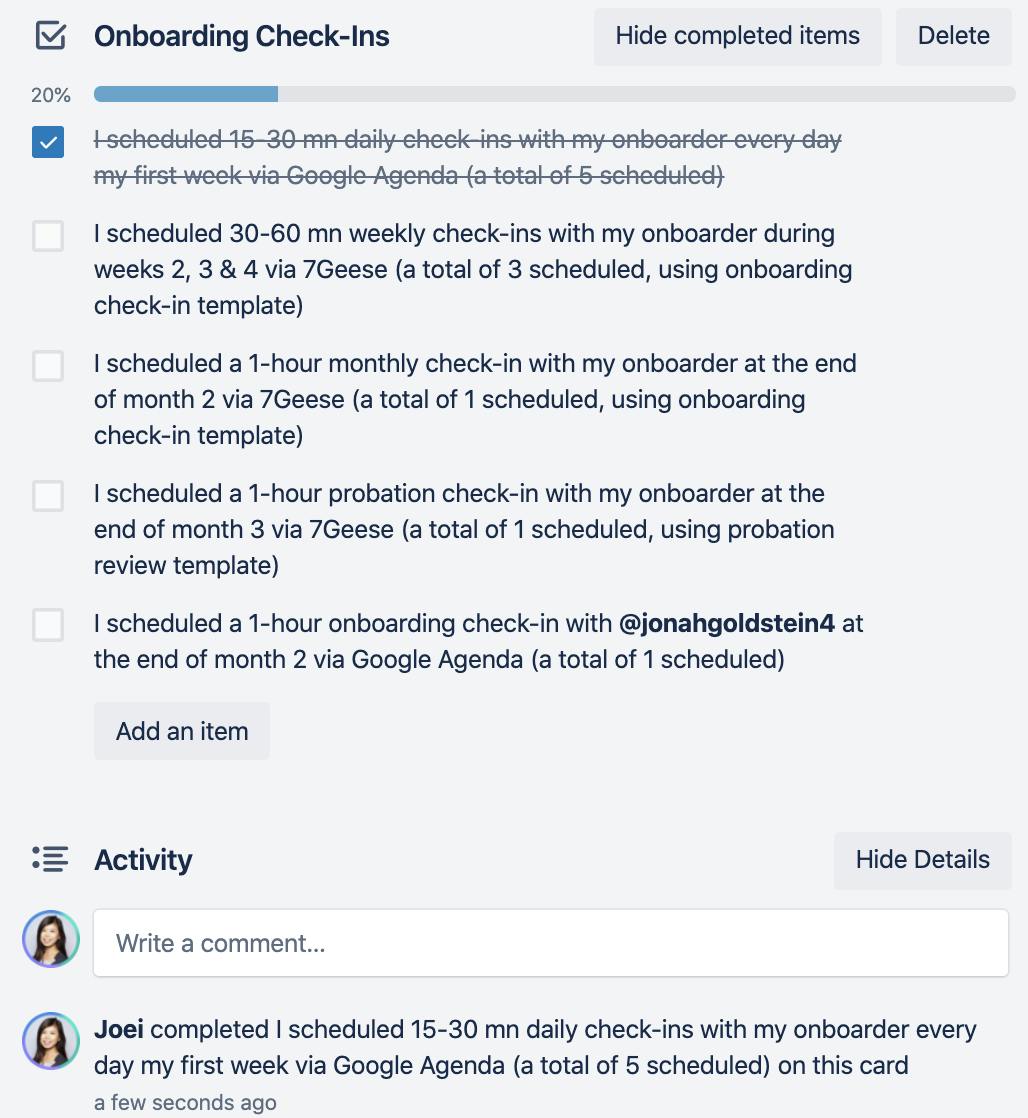
And as you can see, my progress (or lack thereof) is visible and tracked by our Head of Learning and my coaches:
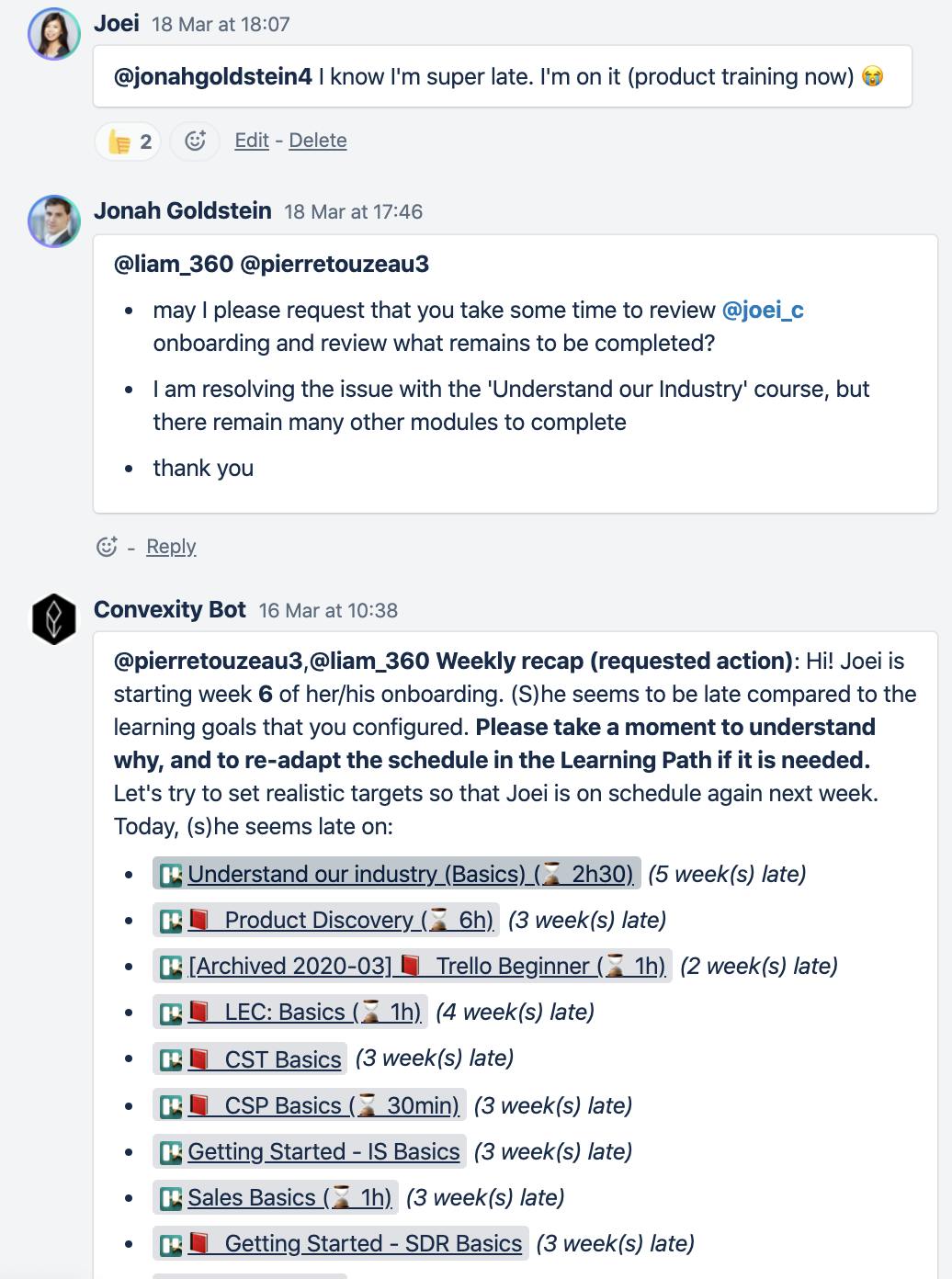
When new hires are learning remotely, a little tailored message at the right time can make all the difference and can help people (myself included) stay on track.
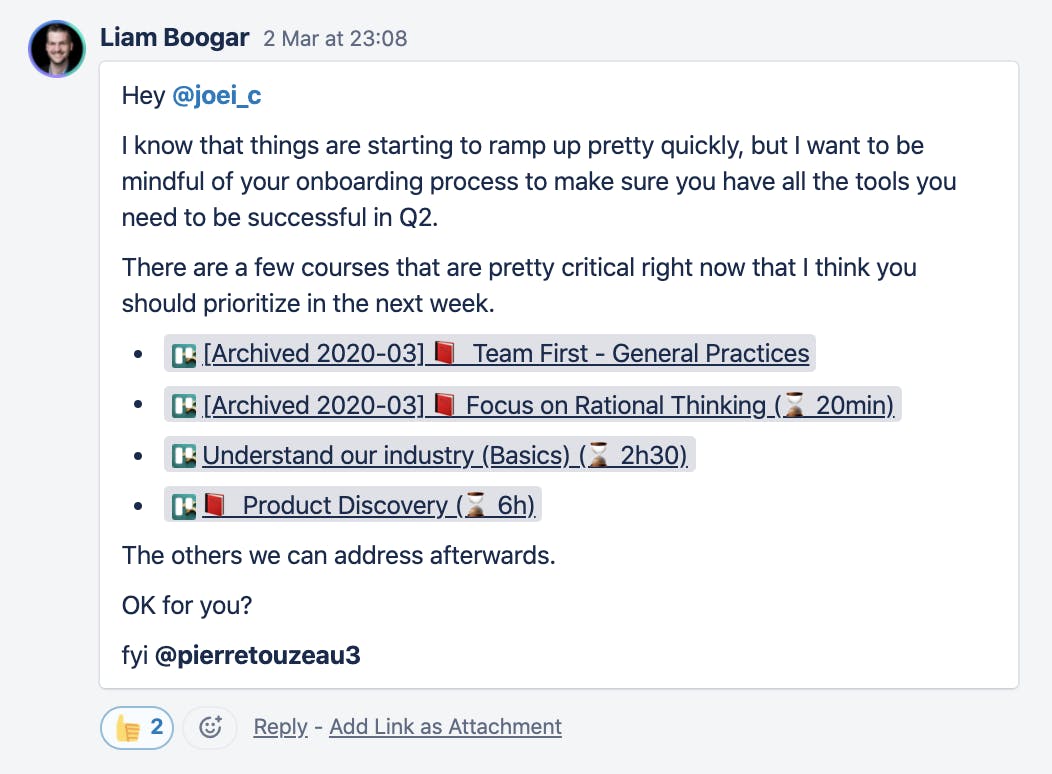
Great onboarding is all about steady progress over time. This is true for your new hires, but it’s also true for your onboarding process itself.
Be sure to check in with your new hires about their onboarding experience. Try to understand how the process is helping them, what’s working, and what needs work.
“It’s important to have that human contact (even via zoom), and to take the person’s temperature,” says Jonah. “During the first week, our coaches check in pretty much every day. After that, they’re spaced out a bit more, but there are still regular touchpoints.”
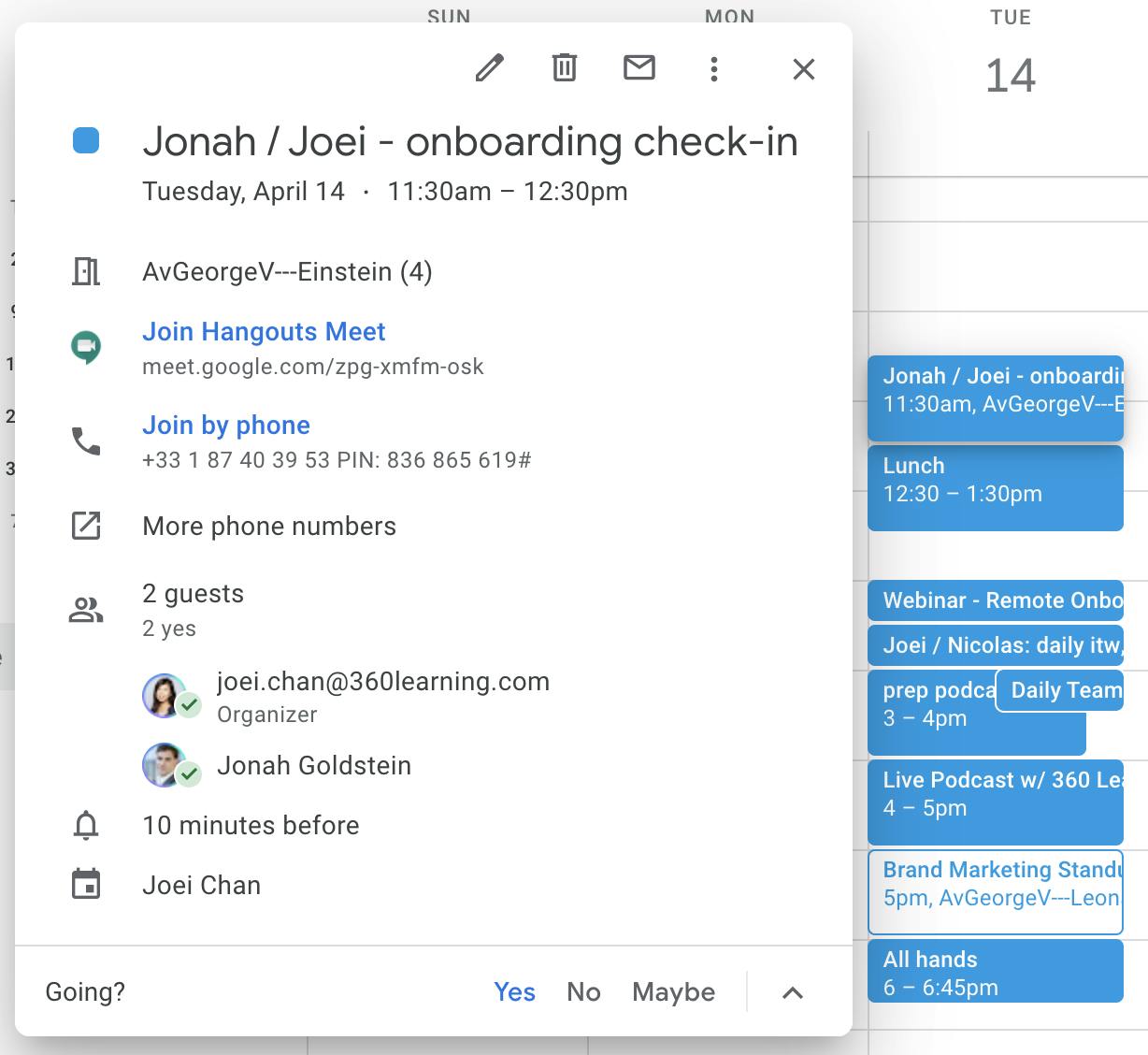
By asking a mix of specific and open questions, you can make it easy for new hires to offer detailed and constructive feedback. This helps you to identify any issues or shortfalls nice and early, increases new hire engagement and motivation.
It also lets your new hires know you’re paying attention and helps you to improve your onboarding process by iteration - even remotely.
As mentioned earlier, instant feedback is requested after every module completion on our learning platform. This helps identify any issues quickly and keeps information fresh. By addressing feedback on an ongoing basis, we can iterate and improve over time.
Related: 9 Tips to Create a Truly Effective Feedback Loop
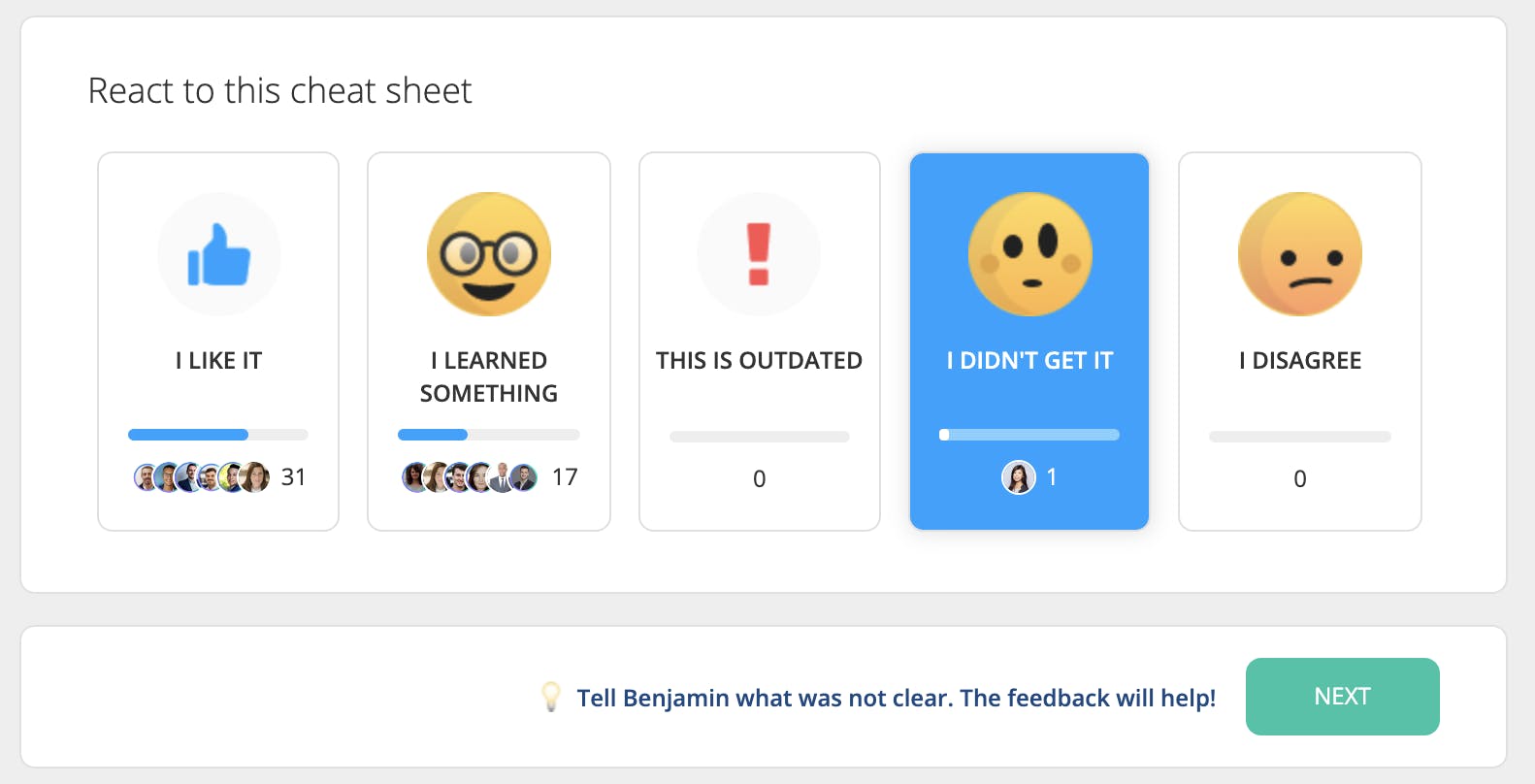
In fact, feedback is such a core value at 360Learning that we even have a dedicated module on the topic as part of our onboarding:
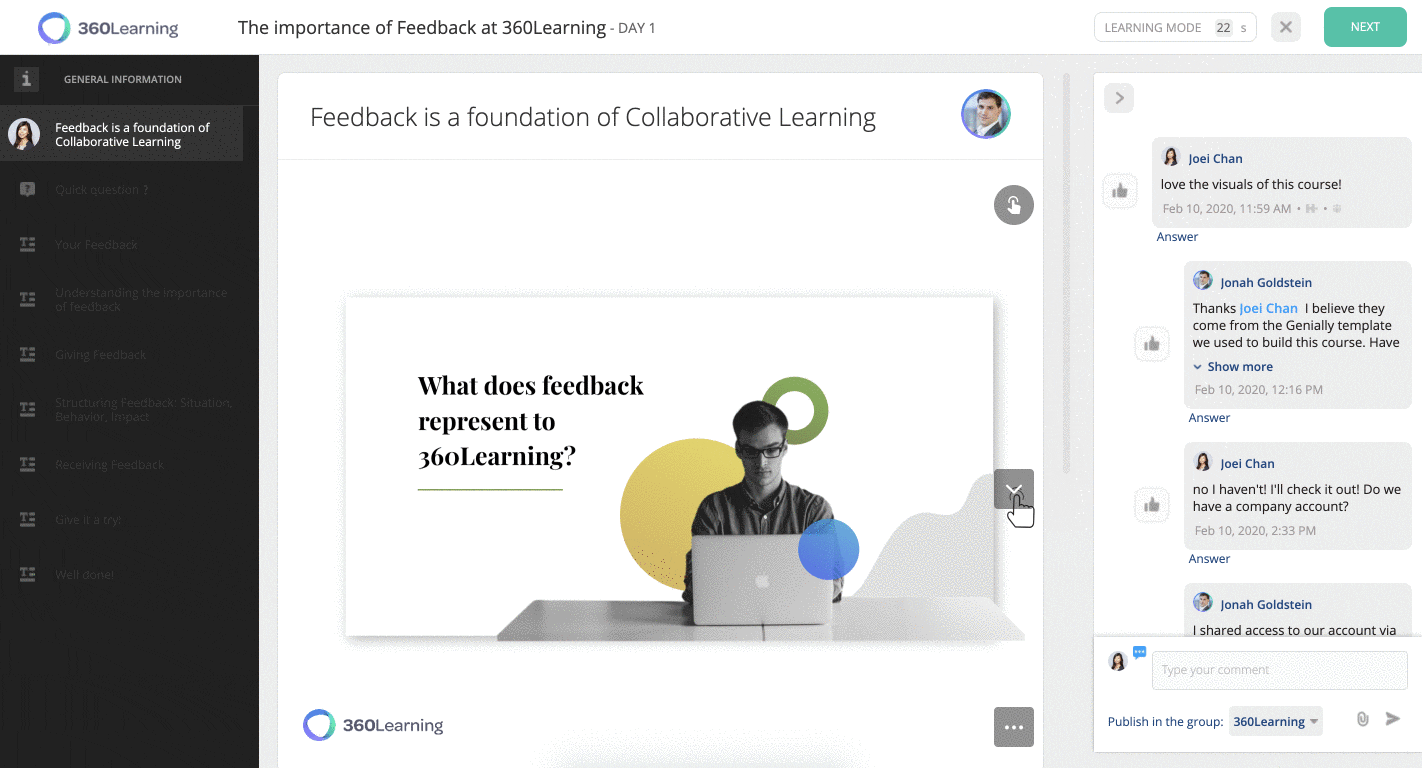
Finally, your onboarding process should include clear and specific metrics for learner progress - especially with remote learning.
These metrics help learners to be clear on what is expected of them, even if they’re learning and working at home. It also helps you to monitor the performance of your onboarding process overall and to track learner satisfaction.
We use a mix of function-specific metrics and general metrics. You also want them to be super specific, measurable, and time-bound.
For example, for our new customer success specialists, we expect them to perform a platform demo (specific) with an overall score of four out of five (measurable) after their first month (time-bound).
We also set metrics for the onboarding process itself, including a satisfaction rating for new hires. “For us, we set a KPI about how satisfied our learners are with the level of support they’re receiving,” says Jonah. “This has been particularly important during the lockdown.”
Tracking metrics like these help us measure the effectiveness of each new hire’s onboarding process, and make it easier to demonstrate the value and importance of onboarding overall.
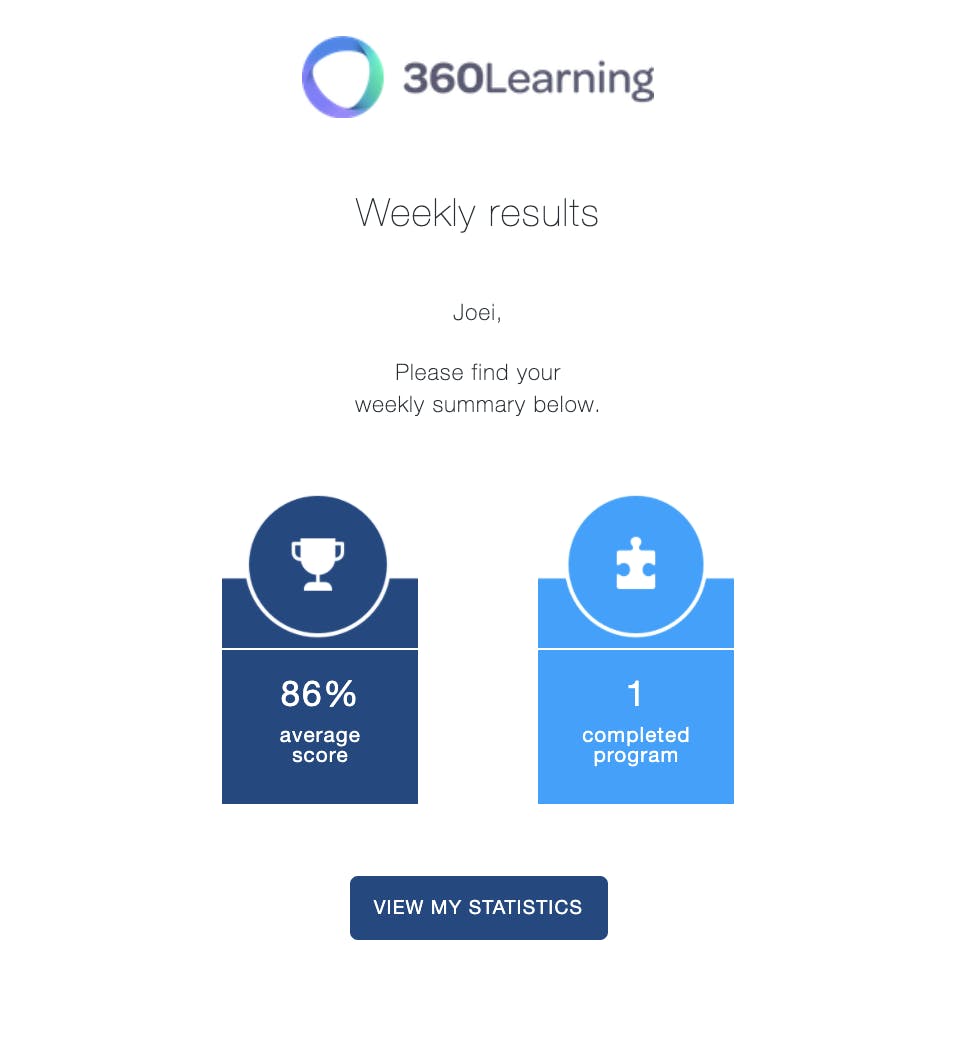
Recognizing learner achievement is also a great way to keep people engaged and motivated, which is why we send completion notes like this:
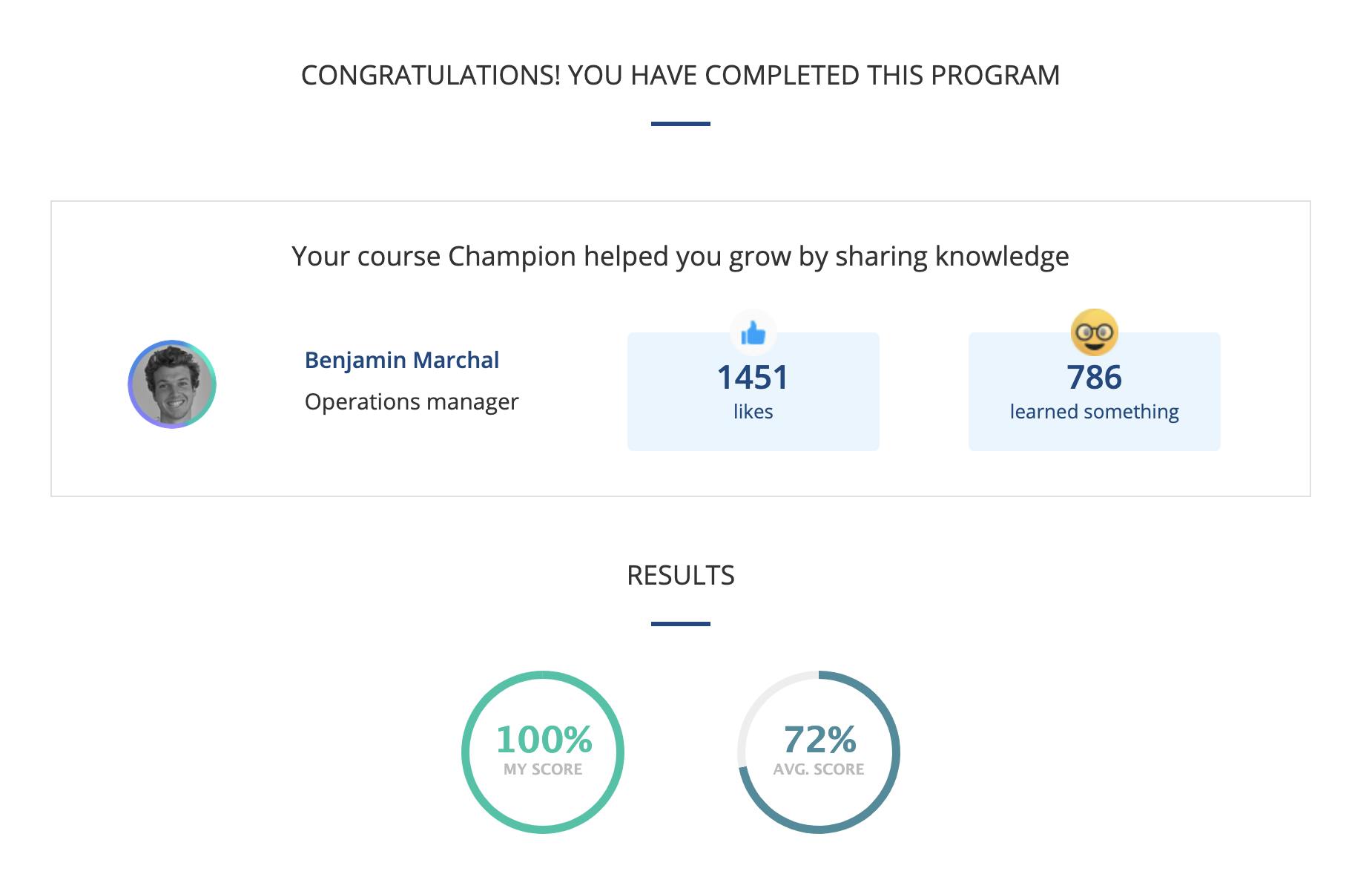
Related: 3 Data-Based Ways To Prove Training ROI (+ Free Training ROI Calculator)
Now we’ve explained our six steps to great remote onboarding, here are a few things you might want to avoid:
Onboarding new hires is a key part of building and maintaining business capability - especially during times of stress or disruption.
No matter what happens in the world, your onboarding process needs to keep going. This is why flexible and remote onboarding is so important.
To give your new hires the best possible remote onboarding, remember our six key steps:
If you need something more customized, get in touch!
A 30-minute overview of the platform
100% tailored to your needs - with ❤️
No commitment. Free as can be.
By providing your contact info, you agree to receive communications from 360Learning. You can opt-out at any time. For details, refer to our Privacy Policy.